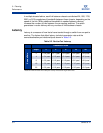
3 – Planning
Performance
59265-00 A 3-3
A
Performance
The SANbox 5802V switch supports class 2 and class 3 Fibre Channel service at
transmission rates of 2-, 4-, 8-,10-, or 20-Gbps with a maximum frame size of
2148 bytes. Each Fibre Channel port adapts its transmission speed to match that
of the device to which it is connected prior to login when the connected device
powers up. Related performance characteristics include the following:
Distance
Bandwidth
Latency
Distance
Consider the physical distribution of devices and switches in the fabric. Choose
SFP transceivers that are compatible with the cable type, distance, Fibre Channel
revision level, and the device host bus adapter. Refer to Appendix A for more
information about cable types and transceivers.
Each Fibre Channel SFP port is supported by a data buffer with a 16 credit
capacity; that is, 16 maximum sized frames. For fiber optic cables, this enables full
bandwidth over the following approximate distances:
13 kilometers at 2-Gbps (1.2 credits/Km)
6 kilometers at 4-Gbps (2.4 credits/km)
3 kilometers at 8-Gbps (4.8 credits/Km)
Bandwidth
Bandwidth is a measure of the volume of data that can be transmitted at a given
transmission rate. An SFP port can transmit or receive at nominal rates of 2-, 4-,
or 8-Gbps depending on the device to which it is connected. This corresponds to
full duplex bandwidth values of 424 MB, 850 MB, and 1700 MB respectively.
XPAK ports transmit at a nominal rate of 10-Gbps which corresponds to a full
duplex bandwidth value of 2550 MB. With a 20-Gbps license key, XPAK ports can
transmit at a nominal rate of 20-Gbps (5100 MB bandwidth).
Multiple source ports can transmit to the same destination port if the destination
bandwidth is greater than or equal to the combined source bandwidth. For
example, two 2-Gbps source ports can transmit to one 4-Gbps destination port.
Similarly, one source port can feed multiple destination ports if the combined
destination bandwidth is greater than or equal to the source bandwidth.


















